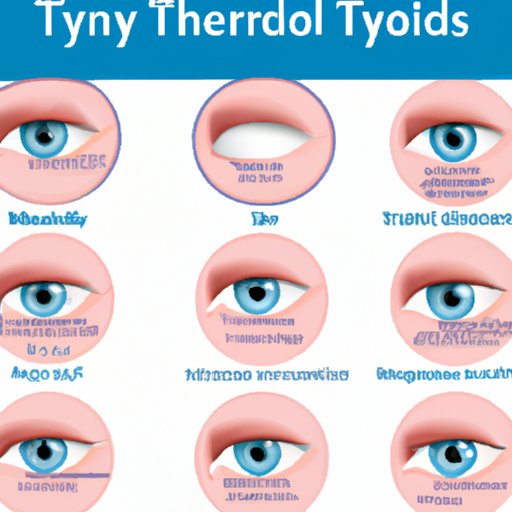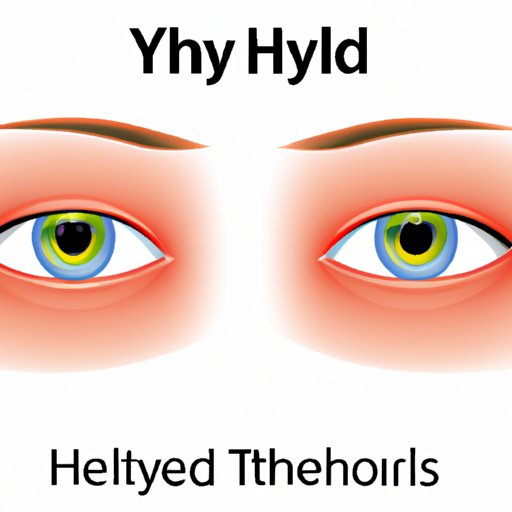I. Introduction
Thyroid eye disease, also known as Graves’ ophthalmopathy, is a condition that affects the eyes of individuals with thyroid dysfunction, specifically hyperthyroidism. This autoimmune disease causes inflammation of the eye muscles and tissue around the eye, leading to a variety of symptoms and physical characteristics. It is essential to identify the symptoms and characteristics early on to seek appropriate treatment.
II. A Visual Guide to Identifying Thyroid Eye Disease: Learn to Spot the Symptoms
The following are some of the most common symptoms of thyroid eye disease:
- Bulging eyes
- Excessive tearing or dryness of the eyes
- Swollen eyelids
- Double vision or blurry vision
- Sensitivity to light
Each of these symptoms can be a result of the inflammation of the eye muscles caused by the disease. Let’s take a closer look at each symptom.
Bulging eyes: Also known as proptosis, bulging of the eyes is one of the most prominent characteristics of thyroid eye disease. It occurs when the inflamed muscles behind the eyes push the eyeballs forward, giving them a protruding appearance.

Excessive tearing or dryness of the eyes: Thyroid eye disease can cause either excessive tearing or dryness of the eyes. The inflamed eye muscles can interfere with the normal tear production, leading to watery eyes. Conversely, dry eyes may develop when the eyelids cannot cover and lubricate the eyes properly.

Swollen eyelids: The inflammation of the eye muscles can cause the eyelids and the tissues around the eyes to become swollen, leading to a puffy appearance. This symptom can be particularly noticeable in the morning or after periods of rest.

Double vision or blurry vision: The swelling of the eye muscles can lead to double vision or blurry vision, making it challenging to focus on objects. This symptom can come and go or stay persistent.

Sensitivity to light: Photosensitivity is another symptom of thyroid eye disease. It can lead to sensitivity to bright lights, such as sunlight or car headlights, making it difficult to see and leading to discomfort in the eyes.

III. The Face of Thyroid Eye Disease: Recognizing the Physical Characteristics of the Condition
Besides the symptoms listed above, thyroid eye disease can present with several physical characteristics on the face. These characteristics are directly related to the inflammation of the eye muscles and surrounding tissues.
Eye prominence: As mentioned earlier, one of the most prominent physical characteristics of thyroid eye disease is the bulging of the eyes, also known as eye prominence. The eyes look larger and more prominent than usual, creating a startled appearance.

Staring appearance: The eye prominence associated with the disease also causes the eyes to appear to be in a constant stare, which can appear unnatural and unsettling.

Retraction of the eyelids: The inflammation around the eyes can cause the eyelids to retract, making the white part of the eye, also known as the sclera, visible above the iris.

Swelling and redness of the eyelids: The eyelids and the surrounding areas can become puffy and red due to the inflammation.

IV. Seeing is Believing: What Thyroid Eye Disease Looks Like in Real Life
Individuals with thyroid eye disease can experience a range of symptoms, with some having more severe cases than others. Here are some personal experiences from individuals with thyroid eye disease:
“It started with a minor irritation in my eyes, but soon enough, my eyes started to bulge, creating a noticeable difference in my appearance. My vision was compromised, making it challenging to read and watch TV. I felt insecure and anxious about my appearance, but with the help of my doctor, I was able to get my symptoms under control.” – Jane, 47
“I had always had somewhat droopy eyelids, but when my thyroid started acting up, my eyes almost popped out of my head. I was embarrassed to go out in public and avoided eye contact.” – Roger, 53
Here are some pictures to help readers understand what thyroid eye disease looks like:

V. Picture Perfect: A Photographic Overview of Thyroid Eye Disease Symptoms
It can be challenging to understand the progression of thyroid eye disease symptoms by simply reading descriptions. That’s why we’ve gathered a series of pictures to help illustrate the different stages of thyroid eye disease symptoms:

As the pictures illustrate, thyroid eye disease can cause various degrees of eye prominence, double vision, and eyelid retraction. These pictures can help individuals identify whether they may have thyroid eye disease and seek medical attention promptly.
VI. Eyes Wide Open: A Detailed Description of the Appearance of Thyroid Eye Disease
Thyroid eye disease affects not only the functionality of the eyes but also their appearance. Here is a breakdown of how the disease causes changes in the way the eyes look:
Eye prominence: As the inflammation affects the muscles and tissues around the eyes, they become enlarged, causing the eyeballs to protrude outward.

Eyelid retraction: The inflammation can also cause the eyelids to retract, making the white part of the eye above the iris visible.

Staring appearance: The combination of the enlarged eye muscles and eyelid retraction can create a staring appearance in individuals with thyroid eye disease.

Double vision: In more severe cases, the inflammation of the eye muscles can cause the eyes to become misaligned, leading to double vision and difficulties focusing.


VII. How to Recognize Thyroid Eye Disease: A Comprehensive Guide to Identifying Symptoms
It is essential to recognize the symptoms and physical characteristics of thyroid eye disease early on to seek appropriate treatment. Here’s a quick recap of the main symptoms and physical characteristics:
- Bulging eyes (eye prominence)
- Excessive tearing or dryness of the eyes
- Swollen eyelids
- Double vision or blurry vision
- Sensitivity to light
- Retraction of the eyelids
- Puffy and red eyelids
- Staring appearance
To best recognize and identify thyroid eye disease, it is essential to see your doctor for a comprehensive eye exam. Your doctor can evaluate your symptoms and physical characteristics of your eyes and recommend appropriate treatment options depending on the severity of your condition.
VIII. Conclusion
In conclusion, thyroid eye disease can cause a range of symptoms and physical characteristics directly related to inflammation of the eye muscles and tissues. Early recognition of the symptoms and physical characteristics is crucial in seeking appropriate medical treatment. If you suspect that you may have thyroid eye disease, seek the advice of a medical professional.
Remember, the earlier you receive proper treatment, the better the chances of managing the disease successfully.
